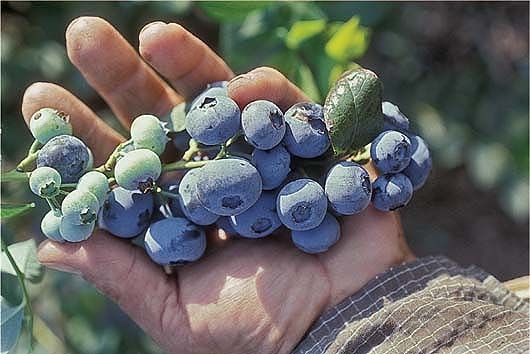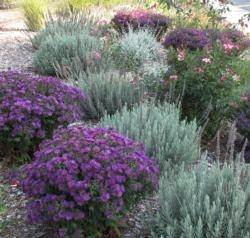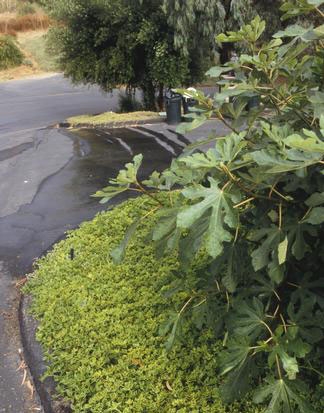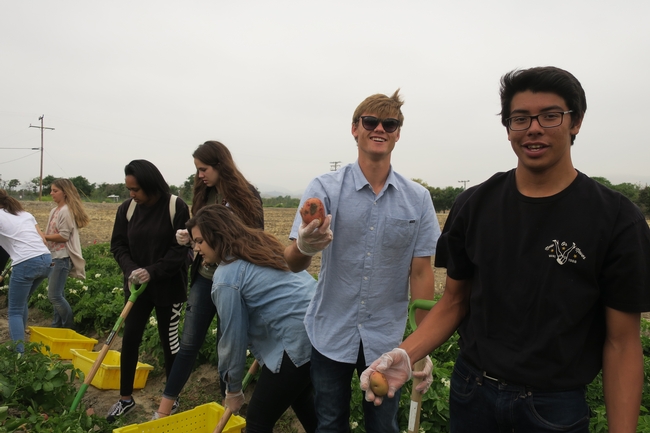
Posts Tagged: Haver
Hiring a pest control company?
Some pest problems can be easily handled at home yourself. But if your pest issue is a bit more...
UC Cooperative Extension Presidential Chair for Agricultural Education formed in Orange County
UC President Janet Napolitano has approved the formation of a $1 million endowment to create the UC Cooperative Extension Presidential Chair for Agricultural Education in Orange County. Half the endowment was donated by the Orange County Farm Bureau; Napolitano matched the contribution through the presidential endowment fund.
The Orange County Farm Bureau is housed at the UC South Coast Research and Extension Center in Irvine. The two organizations have worked together closely since their formation more than 100 years ago.
“What Orange County Farm Bureau and the UC president's office have created will fund agricultural education activities in Orange County and the surrounding region for decades to come,” said UC ANR vice president Glenda Humiston. “This is a way for us to make sure the resources we need are there and that they're targeted for the needs identified by individuals at their local areas.”
President of the Orange County Farm Bureau, Mark Lopez, said the formation of the endowment will help the organization meet its goals.
“In our rapidly urbanizing county, the Farm Bureau is seeking to cement a legacy of ag in Orange County, and invest in the development of future leaders for agriculture,” Lopez said. "This donation, and the formation of the Presidential Chair for Ag Education, is directly in line with the mission of Orange County Farm Bureau.”
Director of the South Coast REC, Darren Haver, who is also a UC Cooperative Extension water resources advisor, holds the chair. He and his farm bureau colleagues will initially use the funds to expand an agricultural leadership and educational program for Orange County youth.
FARMS ( Farming, Agriculture, and Resource Management for Sustainability) Leadership, a program of the Center for Land-Based Learning implemented in Orange County by the Orange County Farm Bureau, in addition to the Orange County Farm Bureau's GROW program, offers field trips and hands-on learning over the course of a school year at locations such as the South Coast REC, acquainting students with wildlife areas, agriculture related businesses and research, colleges and universities where they gain valuable insight into the food and agriculture industry, associated careers and college opportunities. The programs have been open to ag students in Orange County for over five years promoting the importance of agriculture in their daily lives.
“The current programs serve approximately 90 students from four high schools located in Orange County that have agriculture programs,” Haver said. “With this new funding, we will be able to reach beyond the ag students and involve youth interested in math and sciences, but don't know much about agriculture.”
Humiston said she hopes that partnerships like this one can be formed across the state.
“This is a way for us to make sure the resources we need are there and that they're targeted for the needs identified by individuals at their local area,” Humiston said.
In announcing the establishment of the presidential endowment funding in 2014, Napolitano said it is imperative for UC to develop new models of philanthropy that recognize and honor the interests of donors while helping UC address its long-term funding needs.
“By supporting these endowed chairs, donors will be creating a lasting legacy at the university – one that will benefit many generations to come,” Napolitano said.
UC ANR researchers aim to minimize water use in blueberries

The story featured Darren Haver, a UC ANR Cooperative Extension advisor in Orange County and director of the UC South Coast Research and Extension Center in Irvine. At the center, blueberries are being grown with varying amounts of water to compare yield and quality. Because of the drought, farmers need to know how to minimize water use while maintaining a viable business.
"Part of my job as an advisor is to take that information and put it in a format that a farmer could use or the general public could use," he said. "It's my job to distill it down."
The story also notes that drought-tolerant dragon fruit are under study at that at the South Coast REC.
"We need to find more crops like this," Haver said.
Other drought news:
Diversification: A Response to Drought
Richard Jones, Growing Produce, April 27
Growers must prepare to make changes, especially if their sole focus is high-value crops, said Samuel Sandoval, UC ANR specialist in water resources management at UC Davis. “We're seeing many growers put a lot of investment risk on a resource — water — that's very unreliable. We need to think ahead of the curve and find systems that are more flexible,” he says. Sandoval's suggestion: diversifying with both permanent and annual crops.
Your water footprint is bigger than you realize
Laura Bliss, The Atlantic CityLab, April 28, 2015
In the developed world, every bite of food, every mile we drive, every light switch we flip relies on water. The average American has a "water footprint" of 2,220 gallons per person, per day. "The numbers are pretty accurate," says Doug Parker, director of the UC Agriculture and Natural Resources California Institute for Water Resources. "But my question is, what do you do with it? If I'm interested in solving the drought in California, using less energy from power plants doesn't really matter because that water can be used downstream by a farmer."
6 ways to reduce water use without killing your garden

For homeowners, there are six key things to do to conserve landscape water, says Karrie Reid, UC ANR Cooperative Extension advisor, in San Joaquin County. Reid gives the following six tips:
- Tune up your irrigation system right away. When water is efficiently and accurately applied, less water is needed to keep plants healthy. Spray heads can get knocked out of alignment and end up spraying the sidewalk, street or driveway and running to the gutter. Check all spray heads to ensure they are hitting the target and twist those that aren't back into place. Some heads have adjustable angles of spray, which can be fixed with a tool available at a hardware store. Look for cocked heads, which spray water up into the air, and sprays blocked by grass or those that have sunk below grade. Make sure all spray heads are made by the same manufacturer and are from the same line so they deliver water at the same rate, otherwise they'll leave dry spots. Low-volume spray heads or rotators deliver water more efficiently.
- Water the whole root zone. On allowed watering days, irrigate until the water reaches 12 inches deep for grass, 12 to 18 inches for shrub and perennials, and 12 to 24 inches for trees. This provides a greater reservoir of water for the plants to draw from, and many will be able to get by on weekly, twice-monthly or monthly irrigation if they are conditioned to send their roots deep. To check the watering depth, use a soil probe or push a long screwdriver into the ground. The depth it reaches easily indicates how deeply the water has infiltrated.
 To check the watering depth, use a soil probe.
To check the watering depth, use a soil probe. - Avoid wasting water to runoff. If water runs off before the watering cycle finishes, split the cycle time. Set the timer to water in two, three or even four cycles at least an hour apart to allow the water to soak in. To ensure water isn't flowing below the root zone, check the watering depth after each cycle.
An irrigation scheduling worksheet created by Loren Oki, UC ANR Cooperative Extension specialist in the Department of Plant Sciences at UC Davis, and Darren Haver, UC ANR Cooperative Extension advisor in Orange County, helps fine tune irrigation timing. The worksheet is available for free online at the Center for Urban Horticulture website http://www.ccuh.ucdavis.edu.
- Switch to inline drip tubing for beds. Drip irrigation applies water where it is needed with less loss to the air. Be sure to lay tubing so water reaches plants' entire root zone.
- MULCH, MULCH, MULCH. Adding 3 or 4 inches of organic material such as wood chips, shredded bark or bark nuggets will improve soil health while retaining water and lowering stress on your plants. Place mulch away from the street curb to prevent heavy rains from washing it into the storm drains.
- Replace water-needy plants with low water users in the fall. All plants use a lot of water to get established when they are planted in the spring and summer, and for about a year after. Trees may need extra water for several years until their roots have grown well into the surrounding soil. By waiting until temperatures cool in the fall to plant, it will be easier to abide by the water restrictions. It's also important to use hydrozoning, which means placing plants with the same water needs on the same valve. Otherwise, irrigating to the thirstiest plants on that station will give other plants more water than they need.
 Inline drip tubing applies water where it is needed.
Inline drip tubing applies water where it is needed.

Residential runoff still contains banned chemicals
Pesticides that have not been sold at the retail level for years are still regularly found in residential runoff water, according to research in Sacramento and Orange counties by UC scientists. So called “legacy pesticides” are probably old products that homeowners still have on their garage shelves and are still using to control pests.
An earlier study by the California Department of Pesticide Regulation and the UC Integrated Pest Management Program found that 60 percent of pesticides sold to consumers are for ant control. For that reason, UC Cooperative Extension specialist in landscape horticulture Loren Oki of UC Davis and UC Cooperative Extension water resources/water quality advisor Darren Haver focused on ant control pesticides in their residential runoff research project. The scientists collected 830 water samples from the storm drains in four Sacramento County neighborhoods and four Orange County neighborhoods between 2006 and 2010.
“In Sacramento County, we trained a team of about 25 volunteer UC Master Gardeners to collect the samples,” Oki said. Orange County samples were collected by Haver and his staff. All the samples were sent to UC Riverside for analysis.
“Pesticides that have been off the market since 2004 are still found in the water,” Oki said. “We found organophosphates – diazinon and chlorpyrifos – in differing amounts, typically more in Orange County than Sacramento County. We also found a fairly new pesticide, fipronil, in most of our water samples.”
The scientists also noted random spikes in the amount pesticides in runoff water, unconnected with storms or other conditions, which suggested that they were directly associated with particular pesticide applications in the neighborhoods.
There are several ways homeowners can help prevent contamination of the California water supply. For one, dispose of old pesticides properly. Most cities and counties have programs for disposal of household hazardous waste.
When using pesticides, Oki suggests residents carefully read the label and use common sense.
“Don’t put pesticides on impervious surfaces, like concrete walkways and driveways,” he said. “Don’t put pesticides in garden areas where runoff might be generated. That runoff will carry the pesticides with it.”
Residents can also minimize the amount of water runoff from the property. Oki suggests reducing irrigation and targeting the water application properly. In addition, promote soil infiltration by promoting soil health.
“If you don’t generate runoff, you won’t have pesticides running off too,” Oki said.

Residential runoff can convey pesticides into water supplies.



